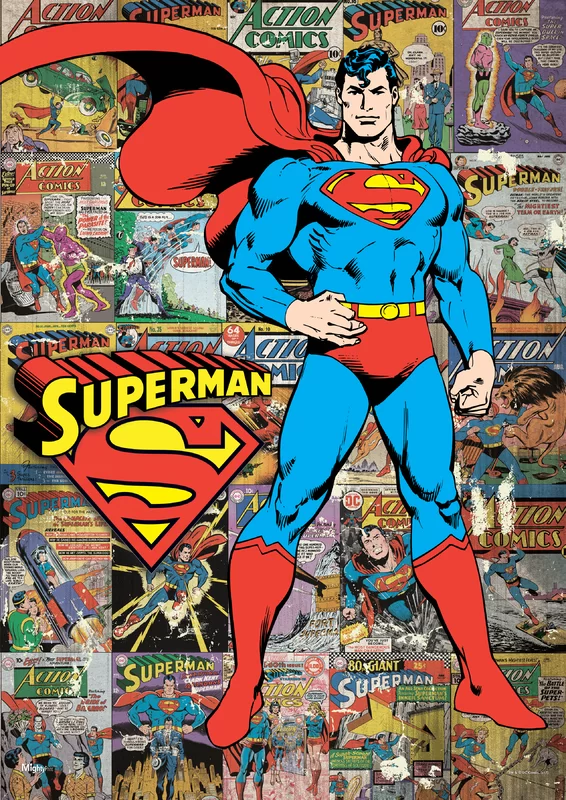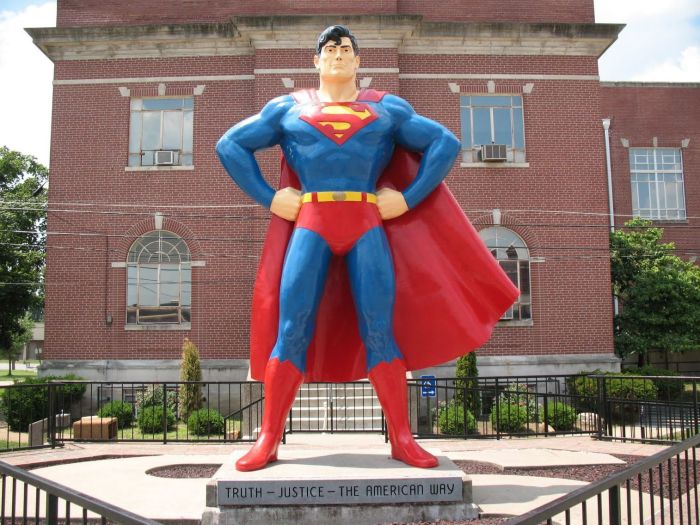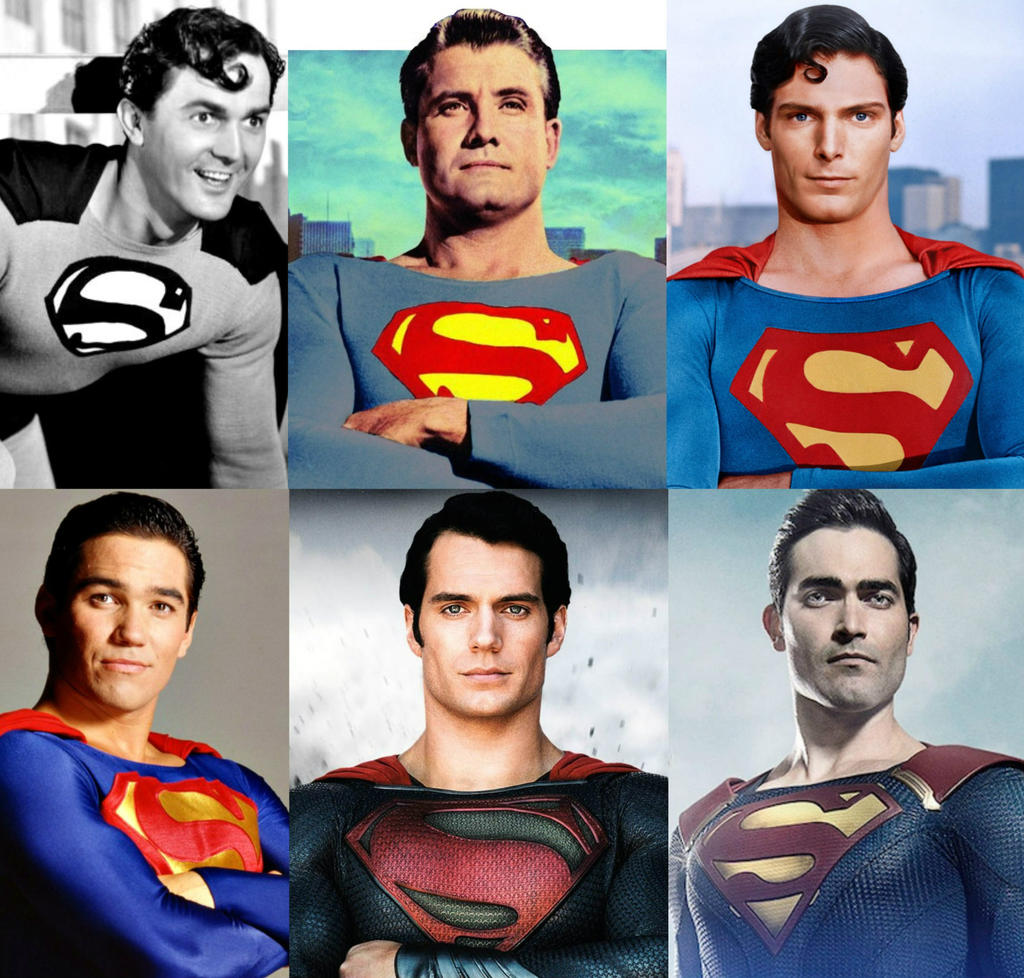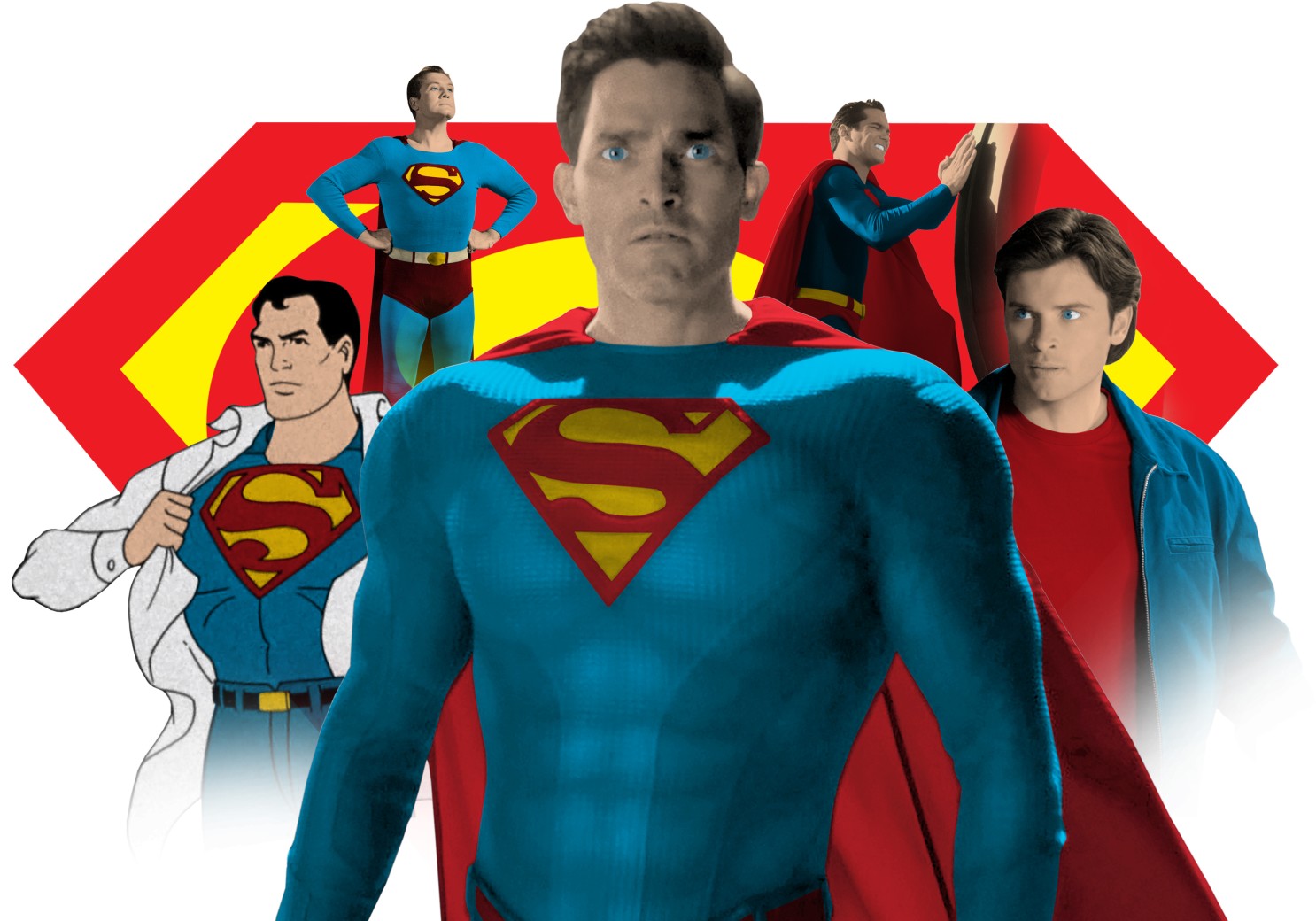
|
|
Metropolis - 1927 Silent Science Fiction Film
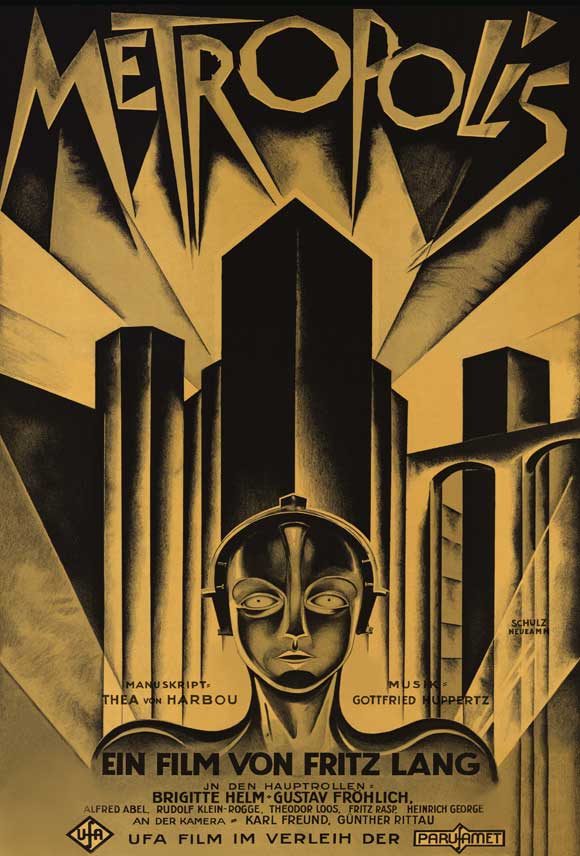
Metropolis is a silent science fiction film created by the famed Austrian director Fritz Lang. Produced in Germany in the Babelsberg Studios during the brief years of the Weimar Republic and released in 1927, it was the most expensive silent film of the time, costing approximately 7 million Reichsmark (equivalent to around $200 million in 2005) to make. The screenplay was written in 1924 by Lang and his wife, Thea von Harbou, and novelized by von Harbou in 1926. It is set in a futuristic urban dystopia, and, like its contemporary The Battleship Potemkin, addresses the then-current political themes of capitalism v. communism.
There are multiple versions of Metropolis. The original German version remained unseen for many decades. Of this version, a quarter of the footage is believed to be permanently lost. The U.S. version, shortened and re-written by Channing Pollock, is the most commonly known and discussed.
The film is set in the year 2026, in the extraordinary Gothic skyscrapers of a corporate city-state, the Metropolis of the title. Society has been divided into two rigid groups: one of planners or thinkers, who live high above the earth in luxury, and another of workers who live underground toiling to sustain the lives of the privileged. The city is run by Johhan 'Joh' Fredersen (Alfred Abel).
The beautiful and evangelical figure Maria (Brigitte Helm) takes up the cause of the workers. She advises the desperate workers not to start a revolution, and instead wait for the arrival of "The Mediator", who, she says, will unite the two halves of society. The son of Fredersen, Freder (Gustav Frohlich), becomes infatuated with Maria, and follows her down into the working underworld. In the underworld, he experiences firsthand the toiling lifestyle of the workers, and observes the casual attitude of their employers (he is disgusted after seeing an explosion at the "M-Machine", when the employers bring in new workers to keep the machine running before taking care of the men wounded or killed in the accident). Shocked at the working conditions, he joins her cause. Meanwhile his father Fredersen learns of the existence of the robotic gynoid built by the scientist Rotwang (Rudolf Klein-Rogge) and orders Rotwang to give the robot Maria's appearance. (Rotwang had wanted to give the robot the appearance of Fredersen's dead wife, Hel; both men had been in love with her, but in the end she had married Fredersen). By doing so he wants to spread disorder among the workers that would give him the pretext to carry out a retaliatory strike against them.
Rotwang with his invention, which in the original script was called FuturaThe real Maria is imprisoned in Rotwang's house in Metropolis, while the robot Maria becomes an exotic dancer in the city's Yoshiwara nightclub, fomenting discord among the rich young men of Metropolis. The workers are encouraged by the robot Maria into a full-scale rebellion, and destroy the "Heart Machine", the power station of the city. However, the destruction of the machine leads to the city's reservoirs overfilling, which floods the workers' underground city and seemingly drowns their children, who were left behind in the riot. (The children are in fact saved in a heroic rescue by Freder and Maria, without the workers' knowledge.) When the workers realize this, they attack out into the gridlocked and confused upper city, foreshadowing the "destruction of the enemy in the citadel" ending still seen in films. The crowd breaks into the city's entertainment district and captures the robot Maria, whom they believe is responsible for drowning their children. They burn the robot at the stake, and when Freder sees this, he believes that it is the real Maria and despairs. However, Freder and the workers then realise that "Maria" is in fact a robot, and see the real Maria being chased by Rotwang along the battlements of the city's cathedral. Freder chases after Rotwang, resulting in a climactic scene in which Joh Fredersen watches in terror as his son struggles with Rotwang on the cathedral's roof. Rotwang falls to his death, and Maria and Freder return to the street, where Freder unites Joh and Grot, the workers' leader, fulfilling his role as the "Mediator".
Themes
One of the most impressive scenes features the flooding of the underground workers' cityThe film contains a scene where Maria retells a variation of the story of the Tower of Babel from the Biblical book of Genesis, but in a way that connects it to the situation she and her fellow workers face. The scene changes from Maria to creative men of antiquity deciding to build a monument to the greatness of humanity and the creator of the world, high enough to reach the stars. Since they cannot build their monument by themselves, they concentrate workers to build it for them for wages. The camera focuses on armies of workers led to the construction site of the monument. They work hard but cannot understand the dreams of the Tower's designers, and the designers don't concern themselves with the mind of their workers. As the film explains, "The dreams of a few had turned to the curses of many". It then ironically inverts the original story's conclusion, noting that the planners and the workers spoke the same language but didn't understand each other. The workers revolt and in their fury destroy the monument. As the scene ends and the camera returns to Maria, only ruins remain of the Tower of Babel. This retelling is notable in keeping the theme of the lack of communication from the original story but placing it in the context of relations between social classes and eliminating the presence of God.
The entire film is dominated by technology, with Lang using a mixture of both 1920s and futuristic devices. Much of the technology portrayed in the film is unexplained and appears bizarre—such as the enormous "M-Machine" and the "Heart Machine". Whilst the Heart Machine is implied to be the electrical power station of the city and appears to be a kind of Wimshurst machine, the purpose of the M-Machine is never revealed, despite it playing a significant part in the film. Early in the film there is a shot showing two unfamiliar types of clock: a 10 hour or metric clock and a clock with a 24 hour analog dial. While Freder is in the subterranean factories, he swaps places with an exhausted worker and takes over his seemingly pointless task—moving the dials of a gigantic clock-like device in accordance with flashing light bulbs. It is possible that the pointlessness of the task was purposeful in the movie, yet the novel reveals that it runs the massive system of Paternoster-lifts in the New Tower of Babel. If so, the machine expresses an explicity Marxist idea of workers alienated from their produce. However, other machines featured in the film anticipate future inventions: Joh Fredersen's office has a television-like device which allows him to contact his overseers in the factories, and built into his desk is an electronic console which allows him to remotely open doors, etc. Also in his office is an automated electronic ticker-tape, with a weary and frustrated clerk constantly writing down the latest stock market prices. In the city itself, we see a mixture of futuristic monorails and airships combined with 1920s-style cars and aircraft.
Dualism is a running theme amongst many of the characters, who demonstrate that they cannot be confined to the rigid class system of the city. The workers are dehumanised, existing either as part of a mob or as work-units, almost part of the machines themselves (the shots of them working do not let the viewer see their faces), and yet they are also human beings who are being exploited. Rotwang is an intelligent philosopher, in many ways far more prescient than Joh Frederson, but also a crazed and selfish man who uses his skills for his own purposes. Joh Frederson cannot reconcile his role as leader of the city and as a father, which leads him to make rash and damaging decisions. Meanwhile, Maria expresses this theme most literally of all by being physically replicated as a robot. As such, the naive ideal of creating a simple and rigid system of life where everyone fits neatly into their role is shown to be a fallacy.
The ultimate expression of technology in the entire film is the female robot built by Rotwang, referred to as the Maschinenmensch or "Machine Human" although it is often translated as "Machine Man" in the US version. In the original German version Rotwang's creation is a reconstruction of his dead lover, a woman called Hel (a reference to the Norse goddess Hel). Both Rotwang and Joh Fredersen were in love with her. She chose Fredersen and became Freder's mother, though she died in childbirth. Rotwang, insanely jealous and angry about her death, creates the Maschinenmensch Hel. In the US version, The Machine Man is merely a fully functioning automaton which can be programmed to perform a variety of human tasks, whilst its appearance can be synthesised to resemble any human being.
In the U.S. version, the Machine Man is sentient, and has its own agenda different to that of its creators. It performs the required task of fomenting revolution, but then becomes an exotic dancer, turning the young men of Metropolis against one another for its own entertainment. This echoes themes from Karel Capek's 1921 play Rossum's Universal Robots and anticipates the themes of many late-twentieth century films, in which seemingly unsentient machines gain consciousness and turn against the intentions of their creators.
Part of Fritz Lang's visual inspiration for the movie came during a trip to Manhattan, New York. He is quoted on the DVD of the Murnau Foundation version as saying "I saw the buildings like a vertical curtain, opalescent, and very light. Filling the back of the stage, hanging from a sinister sky, in order to dazzle, to diffuse, to hypnotize." Lang, in his later years did claim New York inspired Metropolis, but a mention of the script for Metropolis being recently finished is made in the Licht-Bild-Bühne journal of June 1924, Lang traveled to New York in October of the same year.
Rotwang's home is decorated with a pentagram which may be seen as being an symbol of Pythagoreanism, an ancient Greek philosophy, or of magic.
Architecture & Visual Effects
The film features special effects and set design that still impress modern audiences with their visual impact—the film contains cinematic and thematic links to German Expressionism, though the architecture as portrayed in the film appears based on contemporary Modernism and Art Deco. The latter, a brand-new style in Europe at the time, had not reached mass production yet and was considered an emblem of the bourgeois class, and similarly associated with the ruling class in the film.
The Tower of BabelRotwang's Art Deco laboratory, with its lights and industrial machinery is considered by some to be a forerunner of the Streamline Moderne style, highly influential on the look of Frankenstein style laboratories and 'mad science' in pop culture. When applied to science fiction, this style is sometimes called Raygun Gothic.
The effects expert, Eugen Schüfftan, created innovative visual displays widely acclaimed in following years. Among the effects used are miniatures of the city, a camera on a swing, and most notably, the so-called Schüfftan process, later also used by Alfred Hitchcock.
The Maschinenmensch, actually played by Brigitte Helm was created by Walter Schultze-Mittendorf. A chance discovery of a sample of "plastic wood" (a kneadable substance designed as wood-filler) allowed him to sculpt the costume like a suit of armour over a plaster cast of the actress. Spraypainted a mix of silver and bronze, it helped create some of the most memorable moments on film. Helm suffered greatly during the filming of these scenes, wearing this rigid and uncomfortable costume, cutting and bruising her. But Fritz Lang insisted on her playing the part, even if nobody would know it was her. Walter Schulze-Mittendorf (Mittendorff), sculptor, is still the owner of the copyrights for the Maschinenmensch - Robotdesign.
Restorations & Re-Releases
DVD cover for the 2002 restored versionOn January 10, 1927 the film premiered in Berlin, with moderate success. In the United States, the movie was shown in a version edited by the American playwright Channing Pollock, who almost completely obscured the original plot, considered too controversial by the American distributors, and is considerably shortened. In Germany, a version similar to Pollock's was shown on August 5. Only copies of these versions—mostly considered as badly-edited—remain today.
The premiere theatrical release and original version is believed to have been 153 minutes long, before it was edited for its second theatrical release in Germany. A quarter of the film is believed to be lost forever.
Several restored versions (all of them missing footage) were released in the 1980s and 1990s, running for around 90 minutes.
In 1984, a new restoration and edit of the film was compiled by Giorgio Moroder, a music producer who specialized in pop-rock soundtracks for motion pictures. Moroder’s version of the film introduced a new modern rock-and-roll soundtrack for the film, as well as playing at 24 frames per second and integrating the captions into the film itself as subtitles. His version of the film is only 80 minutes in length. The “Moroder version” of Metropolis sparked heated debate among film buffs and fans, with outspoken critics and supporters of the film falling into equal camps.
Enno Patalas made an exhaustive attempt to restore the movie in 1986. This restoration was by that time the most accurate, thanks to the script and the musical score that had been discovered. The basis of Patalas' work was a copy in the Museum of Modern Art's collection.
The film fell into public domain in the United States, but was restored to copyright in 1998. The lawsuit Golan v. Gonzalez unsuccessfully attempted to block its copyright restoration.
The F.W. Murnau Foundation released a 123-minute, digitally restored version in 2002, undertaken by Martin Koerber. It included title cards describing the action in the missing sequences and, again, the original music score.
Most silent films were shot at speeds of between 16 and 20 frames per second, but the digitally restored version with soundtrack plays at the standard sound speed of 24 frames per second (25 on PAL and SECAM videos and DVDs), which often makes the action look unnaturally fast. The reason for showing the film at this speed is unclear; a documentary on the Kino DVD edition states that it may have been filmed at 25 frames per second, but this is disputed. There have been reports stating that the world premiere of Metropolis was shown at 24 frame/s, but these, too, are unconfirmed. In the 1970s the BBC prepared a version with electronic sound that ran at 18 frames per second and consequently had much more realistic-looking movement. Since there is no concrete evidence of Fritz Lang's wishes on this subject, it continues to be hotly debated within the silent film community.
